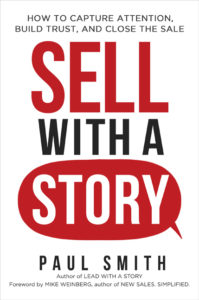Podcast (sell-with-a-story-series1): Play in new window | Download | Embed
Subscribe: RSS
 Has this ever happened to you? You finish what seems like a great sales call. The buyer says that they definitely need what you’re selling, and the price and quality are both fine. They’ll definitely place an order.
Has this ever happened to you? You finish what seems like a great sales call. The buyer says that they definitely need what you’re selling, and the price and quality are both fine. They’ll definitely place an order.
“But,” they say, “now’s just not the right time. Come back in six months.”
Of course it has. It happens to every salesperson. So, what do you do in that situation?
Well, too often we just end up reiterating, in vain, the same benefits we already explained earlier.
But what a lot of great salespeople find more effective is helping the prospect understand the unique problem created by waiting.
Here’s an example. . .
Tiffany Lopez, is a Senior Account Executive at DataServ where they sell Accounts Payable and Receivable software as a service. In late 2013, she closed a sale with a prospect she’d been working with for almost two years—or at least she thought she closed the sale.
The prospect agreed to buy DataServ’s accounts payable software solution, but they didn’t want to start implementation until the following March. They told Tiffany that December and January were busy months when they’re closing the books, and February is audit season. So March would be the earliest the A/P staff would be freed up for an installation like this. “Come back in January and we’ll sign all the paperwork, and then start work in March,” they said.
Well, January came, and Tiffany called the client. And called. And called. No response. Then she figured out why. She saw a news report that the company had just announced an acquisition of one of their competitors and were beginning work immediately to consolidate the new company. And she knew what that meant.
As she explains, “Typically in an acquisition, the acquiring company takes over the accounts payables for the acquired company. That means they might double the volume of payments they have to make, but with the same staffing. Plus, there’s a big onetime effort needed to set all those new vendors up in their A/P system.”
That’s why Tiffany’s calls weren’t getting returned. They were swamped, working overtime on nights and weekends to keep up. In fact, to make matters worse, she found out that one of their key A/P managers had quit in the middle of it all, probably as a result of her excessive workload. That just increased the burden on the remaining staff. They had to hire more than one person to replace her, and training them was a job in itself.
It’s a vicious cycle Tiffany has seen before. Workload goes up, morale goes down, people quit, so workload goes up, etc.
When Tiffany finally heard from her client, it was no surprise that they couldn’t even begin to consider taking on the implementation of the new A/P software now. They were just too busy and had no relief in sight.
The Lesson
The unfortunate and ironic thing about this story is that if they’d implemented Tiffany’s solution when they originally discussed it the previous year, they’d be in a much better position now. The new system is much more efficient than their current system, so when the acquisition happened, they wouldn’t have had to put in nearly as much overtime to keep up. That meant their best A/P manager might not have quit, which also meant they wouldn’t have had to hire and train any new people. Delaying was a decision they were certainly regretting now.
Tiffany shares this story with prospects when they start to drag their feet. It creates exactly the sense of urgency you might expect it to, and not just for prospects that see an acquisition looming in their future. They know that any unexpected project that drops in their lap can result in the same series of unfortunate events, and that they’ll be happier if they install the new system now and not wait.
Whatever your product or service is, there’s likely a similar example of the unfortunate consequences of delay for the buyer. Find it, and create your own “sense of urgency” story.
Use these links to subscribe to this podcast on iTunes or Stitcher, or Podbean.
Source: Sell with a Story: How to Capture Attention, Build Trust, and Close the Sale, by Paul Smith.
—
 Paul Smith is one of the world’s leading experts on business storytelling. He’s a keynote speaker, storytelling coach, and bestselling author of the books Lead with a Story, Parenting with a Story, and Sell with a Story.
Paul Smith is one of the world’s leading experts on business storytelling. He’s a keynote speaker, storytelling coach, and bestselling author of the books Lead with a Story, Parenting with a Story, and Sell with a Story.


 Connect with him via email here.
Connect with him via email here.
Follow him on Facebook, LinkedIn, Twitter, and Instagram.
Sign up for his newsletter here to get one new story a week delivered to your inbox.

